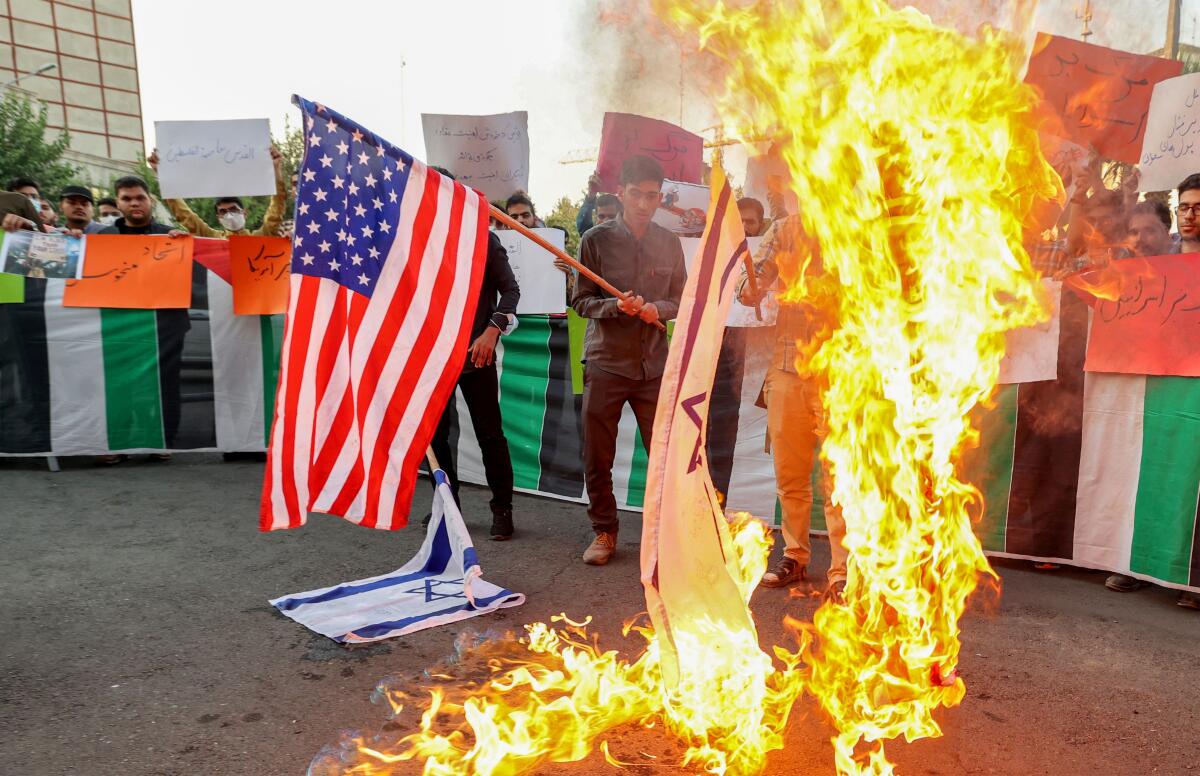Op-Ed: Iran’s robust protest culture has deep roots in an idealistic revolution more than a century ago

Friday is the 116th anniversary of the Persian Constitutional Revolution, the first democratic revolution in the Middle East. And the protest culture spawned by that revolution is alive and well in Iran today.
In recent months, Iranians have taken to the streets over President Ebrahim Raisi’s cuts to food subsidies, which have resulted in price hikes of as much as 300%. Small businesses in the country have temporarily shut down to declare their objection to a sudden jump in sales tax. Iranian women have risked arrest by publicly removing their hijabs, demonstrating against the government’s required Islamic dress code.
Actions like these have their roots in 1906, when, after years of boycotts, strikes and bloody street protests, a band of young Iranian revolutionaries forced the ailing monarch, Muzaffar ad-Din Shah, to sign the country’s first constitution, establishing the rule of law and severely limiting his unchecked powers. The Persian Constitutional Revolution was the first of its kind in any Muslim majority state. Its fundamental goal was to marry traditional Islamic principles with modern concepts such as individual rights and popular sovereignty.
While the revolutionaries lifted some of their language and ideas from Europe and the United States, the movement itself was firmly grounded in more than a century of Persian political thought. The result was a truly indigenous democratic movement, one that led to a freely elected independent parliament and a constitution guaranteeing basic rights for all Iranians.
For all the current hostility between Washington and Tehran, an American who journeyed to Iran more than a century ago remains an unlikely icon there.
The ties between the events of the Persian Constitutional Revolution and the U.S. would go beyond language. In 1907, not long after the constitution was signed, a young American missionary from Nebraska named Howard Baskerville arrived in the northwestern city of Tabriz. Baskerville was there to teach English and preach the gospel. But when Muzaffar ad-Din Shah died shortly after signing the constitution, his young son Mohammed Ali ascended the throne. The new Shah tore up the constitution and attacked the parliament building with the parliamentarians still inside. He then sent his troops to besiege the last bastion of the revolution: the city of Tabriz, where Baskerville resided. Baskerville was caught in the middle of a civil war.
Spurred by the suffering of the people around him, Baskerville gave up his missionary post, surrendered his U.S. citizenship and joined the revolution. On April 20, 1909, he led a force comprising his own students on an ill-fated mission to break through the Shah’s siege and get food to the starving inhabitants of the city. During the attempt, he was shot in the heart and killed.
Baskerville’s death galvanized the revolutionaries. They eventually broke the siege, marched to Tehran and removed Mohammed Ali Shah from his throne. The Persian constitution was reestablished and a new parliament elected. Its first act was to pay homage to the young American missionary who died defending Iran from tyranny.
Of course, Iran’s experiment in constitutional democracy did not last. In 1921, a military commander named Reza Khan marched his troops into Tehran and, with the full backing of the British government, declared a military coup. Iran was transformed once again into an absolute monarchy.
Reza Shah’s Pahlavi Dynasty would itself be overthrown in 1979 by yet another popular revolution — this one replacing 2,500 years of monarchy with the Islamic Republic of Iran, a different form of autocracy that remains in power today.
It is tempting to conclude that the Constitutional Revolution was an abject failure — that there is, in effect, nothing to celebrate on its anniversary. But that would be shortsighted and naive.
The Persian Constitutional Revolution may not have transformed Iran into a real democracy. But it set the precedent for the exercise of people power in Iran, creating one of the most robust protest cultures in the world.
Other recent protests in Iran have seen retirees demanding an increase of pensions and farmers, factory workers, teachers and merchants going on strike to demonstrate against deteriorating living conditions.
Iran’s economy continues to tank, fueling protests and strikes, while prospects of a revived nuclear accord and eased U.S. sanctions look uncertain.
While most of these latest protests are fueled by social and economic issues, demonstrators have increasingly been emboldened to march through the streets calling for the fall of the regime. Beneath the current economic grievances is long-simmering frustration over the same issues that compelled Baskerville to join his Iranian students on the battlefield more than a century ago: that people should be masters of their own fate, should be free to act and think without coercion and should have a say in the decisions that rule their lives.
Today, this vibrant people’s movement has yet to achieve the freedom that all Iranians deserve. But that is not because the people are too weak or the government too strong. It is because the country remains, to this day, a pawn in the hands of global powers. A tyrant stays in power by isolating his people from the rest of the world. In the case of Iran, four decades of sanctions, containment and global isolation imposed by world powers have done the tyrant’s work for him.
The legacy of the Persian Constitutional Revolution can be seen in the Iranians who have never stopped beating on freedom’s door. Now that door is cracking ever so slightly, as a government whose chief duty is to feed and protect its citizens has proved utterly incapable of doing either. Perhaps with just a little more nudging, the door will break open, and the Iranian people will again gain power, as they first did in 1906.
Reza Aslan is a professor of creative writing at UC Riverside. His forthcoming book is “An American Martyr in Persia: The Epic Life and Tragic Death of Howard Baskerville.” @rezaaslan
More to Read
A cure for the common opinion
Get thought-provoking perspectives with our weekly newsletter.
You may occasionally receive promotional content from the Los Angeles Times.










